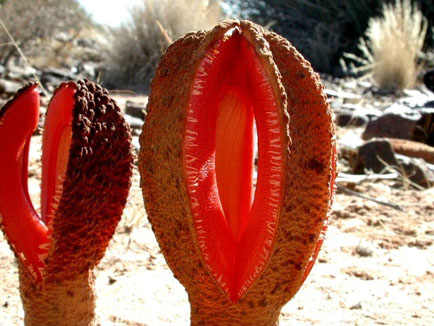Deep in the deserts of southern Africa lies one of nature’s most mysterious and least understood plants Hydnora africana.
Unlike most plants, it lives underground, has no leaves, no stems, and no chlorophyll, and instead depends entirely on other plants for survival.
It is often called the “bizarre flower from below” because the only part that ever emerges from the soil is its strange, fleshy bloom that smells like rotting meat.
Origin and Habitat
Hydnora africana is native to arid regions of southern Africa, particularly in Namibia, South Africa, and Botswana.
It thrives in semi-desert and dry savanna environments, where it grows as a root parasite on the roots of Euphorbia species (succulent plants).
Because it lives underground almost entirely, it can survive long periods of drought and extreme heat.
Unique Structure and Growth
Unlike ordinary plants that rely on sunlight for photosynthesis, Hydnora africana lacks chlorophyll and obtains nutrients by parasitizing its host’s roots.
It has no leaves or green parts just thick, fleshy tissue connected to its host underground.
When the plant is ready to reproduce, it sends a flower-like structure above the soil surface.
This flower is reddish-brown, leathery, and shaped like a trap, with several thick lobes that partially open to reveal its interior.
The design resembles both a fungus and an animal organ, which is part of its unsettling charm.
The Smell of Decay A Clever Strategy
The most striking (and infamous) feature of Hydnora africana is its horrible odor.
The bloom emits a strong smell similar to rotting meat or feces, which helps attract pollinators mainly dung beetles and carrion beetles.
These insects crawl into the flower, lured by the stench, and become temporarily trapped inside.
While trapped, they get covered in pollen. After the flower opens again, the beetles escape and carry pollen to another Hydnora bloom, completing pollination.
This unusual mechanism classifies it as a “trap flower”, similar to the corpse flower (Amorphophallus titanum) and Rafflesia.
Reproduction and Seeds
After pollination, Hydnora africana produces large, underground fruits that can be up to 8 centimeters in diameter.
The fruits contain hundreds of small seeds embedded in a fleshy pulp.
Interestingly, these fruits are edible and are eaten by animals such as jackals, porcupines, and humans in some regions of Africa.
Locals sometimes call it the “jackal fruit.”
Ecological and Cultural Importance
Despite its strange appearance, Hydnora africana plays a small but important role in its ecosystem:
- Provides food for wildlife during dry seasons.
- Supports local beetle populations critical for nutrient cycling.
- Has been used in traditional African medicine to treat ailments such as diarrhea, dysentery, and throat infections.
- Its tannin-rich tissues are also used in tanning leather and producing natural dyes.
Scientific Curiosity and Evolution
Botanists consider Hydnora africana an evolutionary marvel a flowering plant that has completely abandoned photosynthesis.
It belongs to the Hydnoraceae family, one of the few entirely parasitic flowering plant families.
Its existence challenges the typical definition of a plant, showing how life can adapt to extreme and nutrient-poor environments.
Key Facts about Hydnora africana
| Feature | Description |
|---|---|
| Scientific Name | Hydnora africana |
| Common Name | Jackal Food, Underground Flower |
| Family | Hydnoraceae |
| Native Habitat | Southern Africa (Namibia, South Africa, Botswana) |
| Growth Type | Root parasite on Euphorbia species |
| Appearance | Fleshy, brownish flower emerging from soil |
| Smell | Rotting meat (to attract beetles) |
| Pollinators | Dung beetles and carrion beetles |
| Fruit | Edible, underground, up to 8 cm diameter |
| Conservation Status | Not threatened but rarely seen due to its underground lifestyle |





